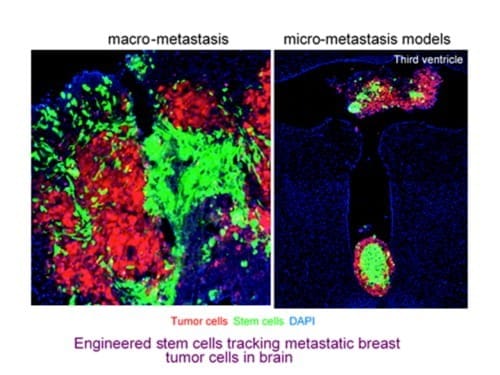
05 Mar Breast Cancer: Using Blood Brain Barrier-Crossing Stem Cells to Attack Metastases
MedicalResearch.com Interview with:

Dr. Shah
Khalid Shah, MS, PhD
Vice Chair of Research, Department of Neurosurgery
Director, Center for Stem Cell Therapeutics and Imaging
Director, Center for Excellence in Biomedicine
Brigham and Women’s Hospital
Associate Professor, Harvard Medical School
Principal Faculty, Harvard Stem Cell Institute
MedicalResearch.com: What is the background for this study?
Response: Approximately 15-to-30 percent of patients with metastatic breast cancer have brain metastasis (BM), with basal-like breast cancer (BLBC) metastasizing to the brain most frequently. The prognosis for BLBC-BM patients is poor, as the blood-brain barrier prevents most therapeutics from reaching the brain. Testing candidate therapies in clinical trials is also challenging because animal models that mimic BM are limited. In this study we engineered a bimodal tumor-suppressing and killing molecule that can be delivered to the brain by stem cells and tested them in mouse models of brain metastases that mimic clinical setting.
MedicalResearch.com: How do the stem cells target the three different patterns of breast cancer metastases to the brain? What are the main findings?

Response: Stem cells have the advantage of being able to cross the blood brain barrier (BBB) and home in on tumors in the brain. Allogeneic stem cell therapies, which use donor tissue samples to create large batches of cells, can produce stem cells efficiently, making them a readily available, “off-the-shelf” technology for administering therapies. Because breast cancer can metastasize to the brain in numerous patterns, we developed and utilized mouse models to reflect the range and complexity of human disease. Our study demonstrate the efficacy of a stem cell–delivered therapeutics against EGFR and DR4/5 in mouse models representing three clinically challenging BM conditions.
MedicalResearch.com: What should readers take away from your report?
Response: Our findings provide a scientific rationale that supports clinical trials of this strategy in patients with BLBC-BM. We hope that approval of that therapy might bolster support for clearance of the therapy developed and used in their current study.
MedicalResearch.com: What recommendations do you have for future research as a result of this work?
Response: This study reports mechanism based simultaneous targeting of EGFR and DR4/5 in BLBC and defines a new treatment paradigm for treatment of brain metastases.
Any disclosures?
K.S. owns equity in and is a member of the Board of Directors of AMASA Therapeutics, a company developing stem cell–based therapies for cancer. K.S.’s interests were reviewed and are managed by Brigham and Women’s Hospital and Partners Health Care in accordance with conflict of interest policies.
Citation:
BY YOHEI KITAMURA, NOBUHIKO KANAYA, SUSANA MOLEIRINHO, WANLU DU, CLEMENS REINSHAGEN, NADA ATTIA, AGNIESZKA BRONISZ, ESTHER REVAI LECHTICH, HIKARU SASAKI, JOANA LILIANA MORA, PRISCILLA KALIOPI BRASTIANOS, JEFFEREY L. FALCONE, ALDEBARAN M. HOFER, ARNALDO FRANCO, KHALID SHAH
SCIENCE ADVANCES03 MAR 2021 : EABE8671
[subscribe]
[last-modified]
The information on MedicalResearch.com is provided for educational purposes only, and is in no way intended to diagnose, cure, or treat any medical or other condition. Always seek the advice of your physician or other qualified health and ask your doctor any questions you may have regarding a medical condition. In addition to all other limitations and disclaimers in this agreement, service provider and its third party providers disclaim any liability or loss in connection with the content provided on this website.
Last Updated on March 5, 2021 by Marie Benz MD FAAD
